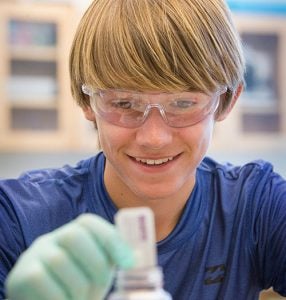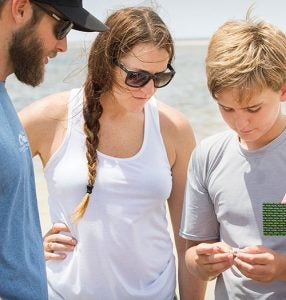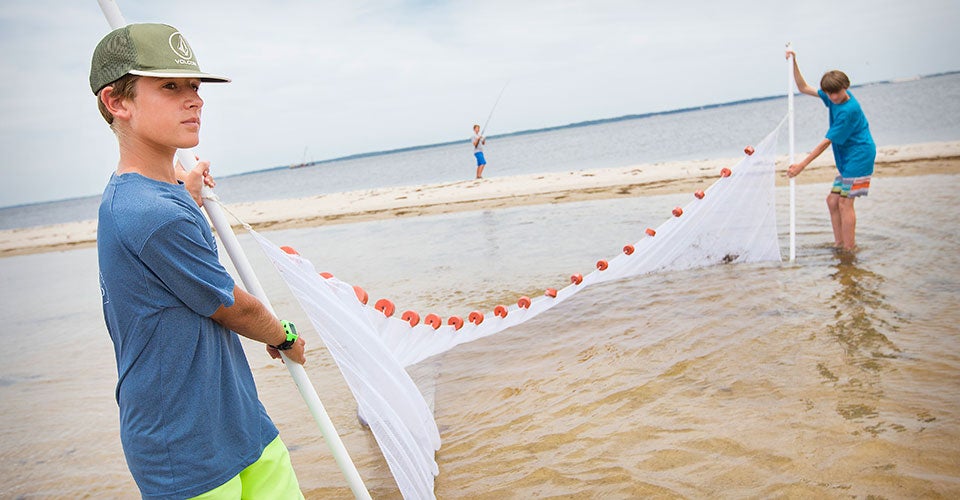COASTAL CAMP
Students explore N.C. estuaries during educational day camp
The campers filed back into the lab after spending the morning collecting water samples at several sites in the ocean and sound along North Carolina’s Outer Banks.
After watching a short video on water quality and stormwater runoff, camp assistant Autumn Reaghard walked them through the process for testing their samples. “What are some of the things we can look for to test water quality?” she asked, then wrote on the whiteboard – pH, temperature and conductivity.
For this experiment, the campers tested bacteria levels. They predicted which sites they thought would have the highest levels, then prepared their samples for testing by drawing off 10 milliliters. The samples were combined with media that would be eaten by the bacteria; after incubating overnight the samples containing bacteria fluoresced under ultraviolet light.
“It’s very important to be precise with your measurements,” Reaghard reminded the campers. “You need exactly 10 milliliters.”
After getting the results the next day, David Sybert, UNC Coastal Studies Institute’s K-12 education specialist, said the campers were remarkably accurate in their predictions.
The eight campers were participants in the UNC Coastal Studies Institute’s summer day camps, which combine STEM education with outdoor activities for students from ages 10 to 15. East Carolina University is the administrative campus for the institute, which is perfectly located in Wanchese for access to freshwater, brackish and saltwater environments.

Henry Stecher, 13, of Kill Devil Hills prepares a water sample to be tested for harmful bacteria.
Activities include snorkeling, kayaking and collecting species data by seining, trawling and hook-and-line fishing.
“We’re trying to build on it a little each year and do additional things,” said Sybert. “We combine fun with learning, and we want to give them a better understanding of what’s out there in the estuary. As they grow up here on the Outer Banks, there is science all around them, so we do some of the things they’re interested in, while also learning something.”
The day camps begin and end at CSI each day, but campers visit a variety of other locations by boat, kayak and van. The first camp of the summer, Exploring Estuaries, was held June 20-24, and Marine Science will be offered from July 11-15.
CSI has also partnered with Jeannette’s Pier for Surf and Science Camp, which was held June 13-17 and runs again July 4-8. The camp focuses on oceanography concepts and wave characteristics while teaching campers to surf.
“That camp teaches physics, oceanography and hydrodynamics,” Sybert said. “They met a surfboard shaper, Scott Busbey, and saw what goes into shaping a board. So they got to surf and learn the science behind it.”
The camps were created in 2013 as part of CSI’s outreach mission, said John McCord, interim director of education, outreach and communication. “The summer camps at CSI provide students with a fun and engaging way to learn science first hand with field and lab experiences that foster student interest in STEM areas. It also exposes students to the place-based research happening at CSI, allowing students to be part of the science that is happening right in their community.”
Alani Guillaume, 10, of Chesapeake, Virginia attended the Exploring Estuaries camp while visiting her grandparents at the Outer Banks. Her favorite part of the camp was the kayaking.
“We went to the Alligator River,” she said, “to see how there could be freshwater and lush forests so close to the beach.”
Sybert ferried the campers via pontoon boat to a sandbar near the western shore of the Roanoke Sound, where they gathered samples of fish and crustaceans with a seine net and a cast net, as well as rod and reel. Seining was the most successful, netting a haul of mullets and silversides, as well as a few small crabs.

Autumn Reaghard, a teacher at Cape Hatteras Secondary School, examines a small crab with instructor David Sybert, K-12 education specialist at the UNC Coastal Studies Institute, and camper Pierce Chase, 11, from Kitty Hawk.
“I caught a fish with my bare hands!” shouted Pierce Chase, 11, of Kitty Hawk as he splashed through the shallow water to add it to the bucket.
Sybert talked with the campers about the characteristics of the species they caught – the light and dark coloring of the small fish that makes them less visible both from above and below, and the anatomy of a blue crab, which grows by shedding its exoskeleton.
“We’ll talk about vertebrates and invertebrates, how these animals fit into the food web, and just get familiar with what’s out here,” Sybert said. “Where did we find them, what do they eat? What do they look like and why?”
The fishing was a highlight for Ian Culpepper, 11, of Manteo. “We fished in the sound from the pontoon boat, with squid for bait,” he said. “That was my favorite part, even though we didn’t catch anything that day.”
Olan Downing, 14, who attended the camp for the second time this year thanks to a scholarship from the Outer Banks Women’s Club, said he caught a crab on his fishing line, but it got off before he hauled it in. “I learned that the Latin word for crab means beautiful swimmer,” he said. (Callinectes sapidus, the scientific name for the blue crab, translates as “beautiful savory swimmer.”)
Guillaume caught her first fish ever during the camp. “It was a croaker,” Sybert said. “We got her picture with it, but she didn’t want to touch it.”
The campers documented their experience by putting together short videos each day and posting photos to Instagram, helping them to think about what they’re doing and reflect on what they’ve learned, said Sybert.
Reaghard, who teaches science at Cape Hatteras Secondary School during the school year, said the summer camp program is a great way for kids to apply what they’ve learned in the classroom. “They get to see the impact of water quality first hand, and see the variety of species and different types of ecosystems right here on the Outer Banks,” she said.
For more information about the UNC Coastal Studies Institute and its camp programs, visit www.coastalstudiesinstitute.org.

Noah Goetsch, 13, of Nags Head (foreground) and Olan Downing, 14, of Kill Devil Hills use a seine net to catch fish and crabs for examination during the Coastal Studies Institute summer camp.
